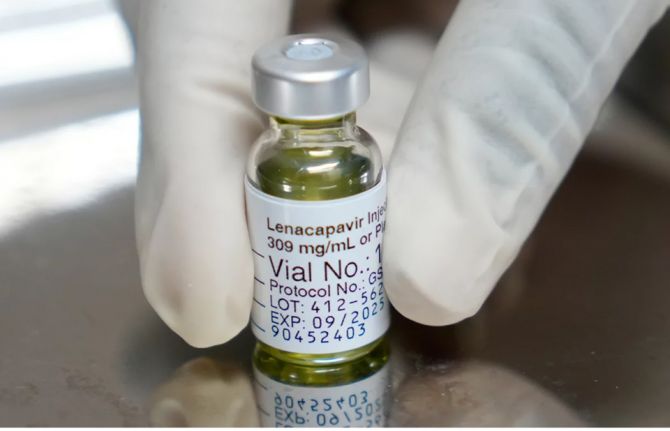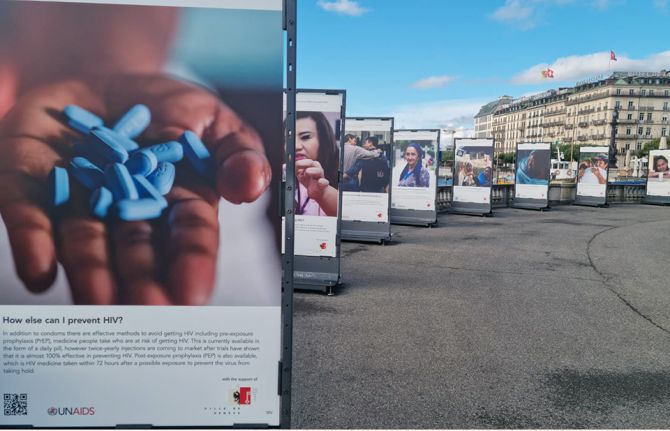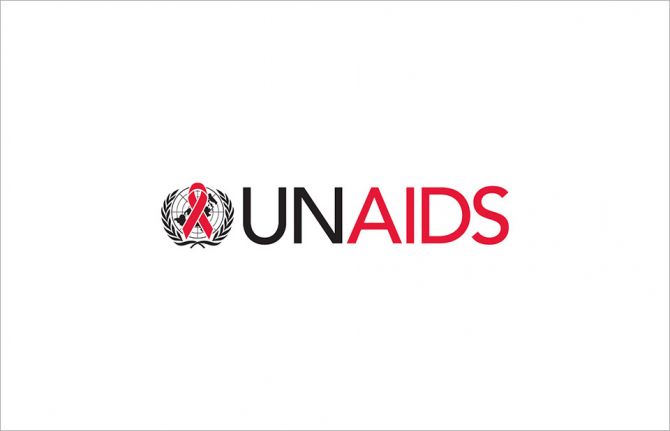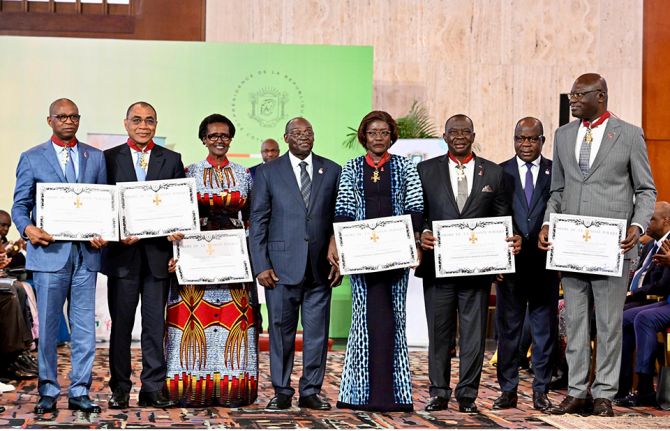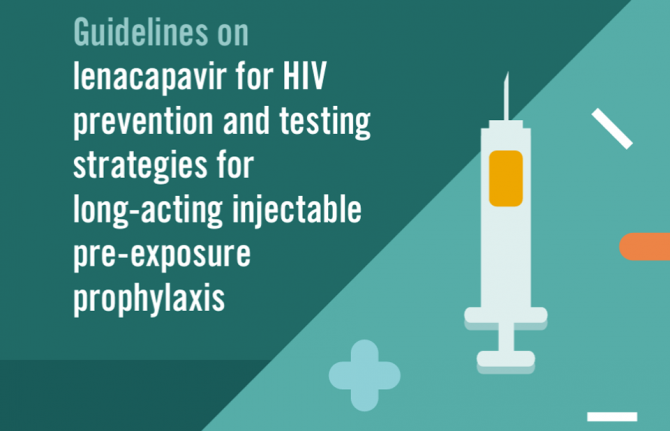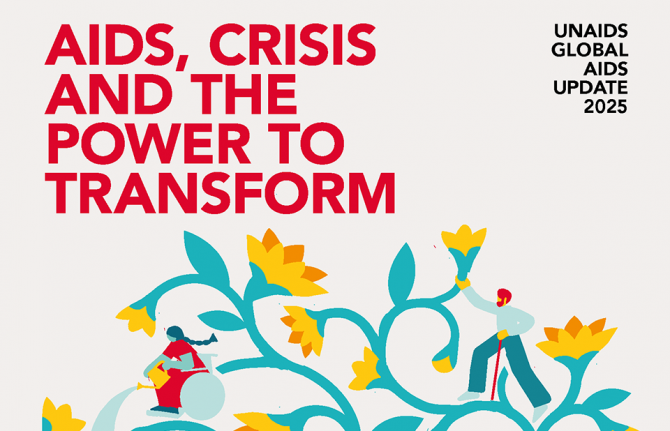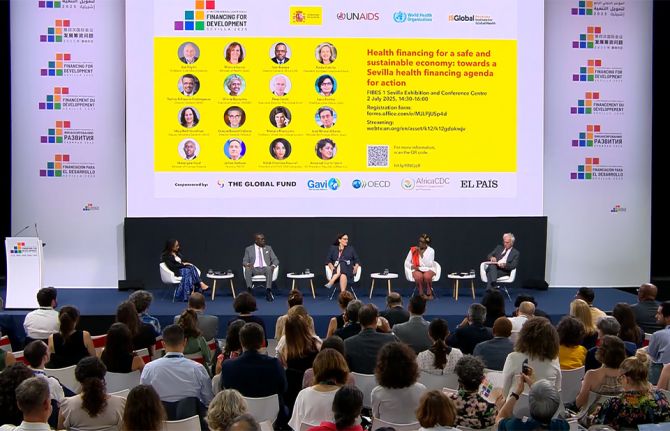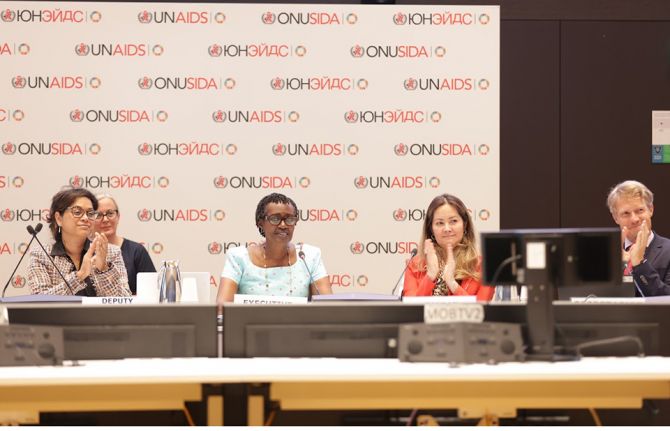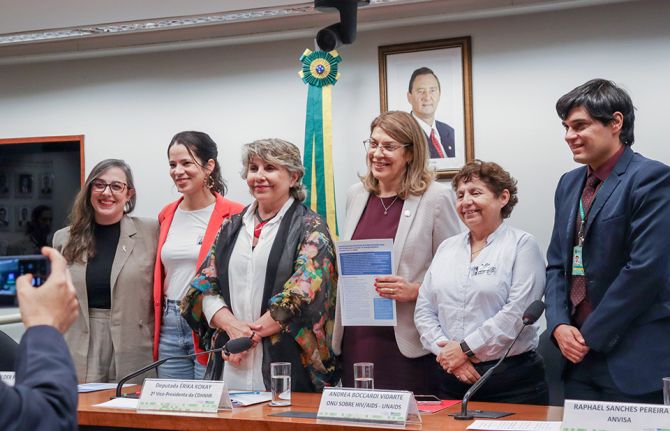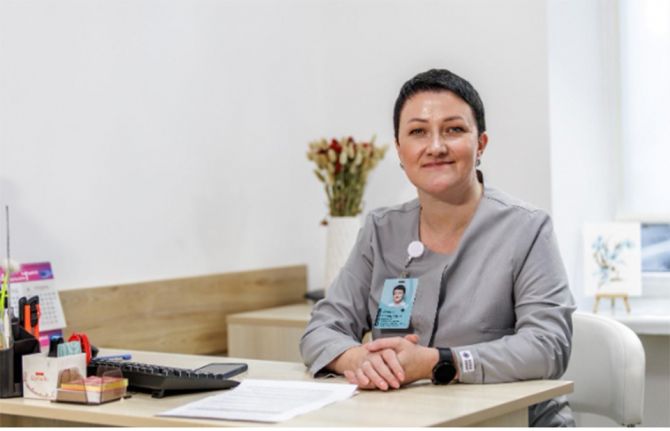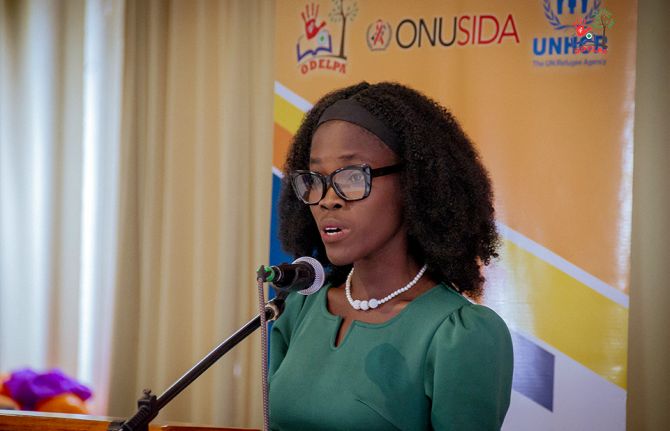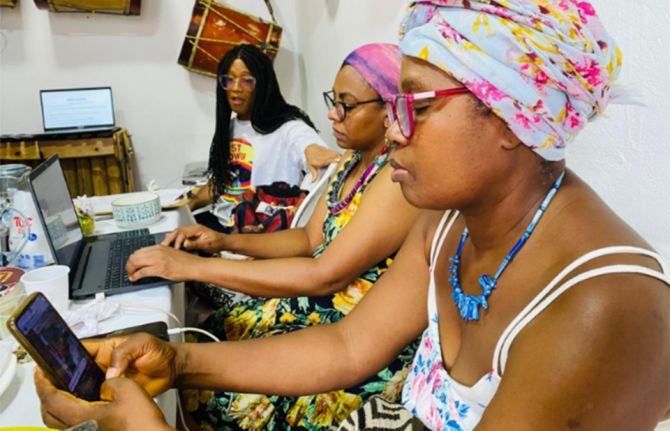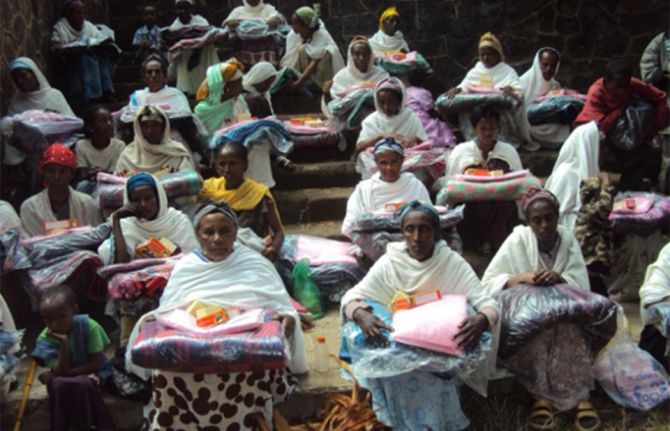
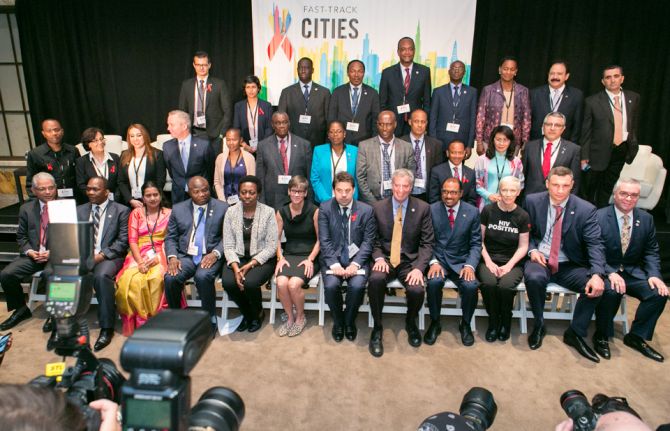
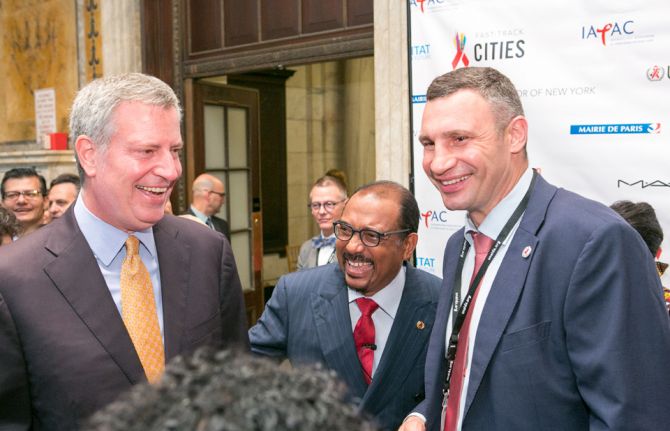

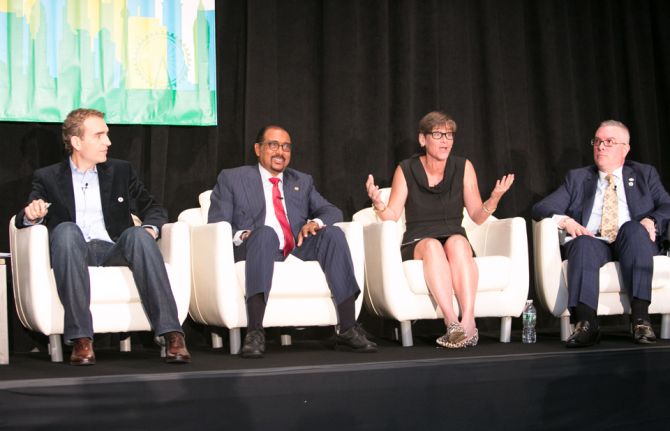

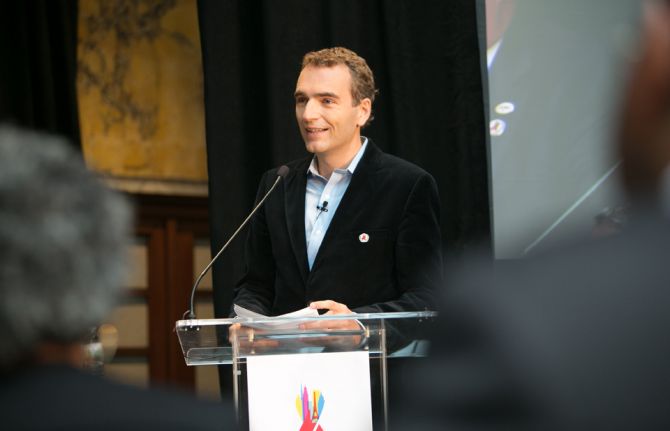
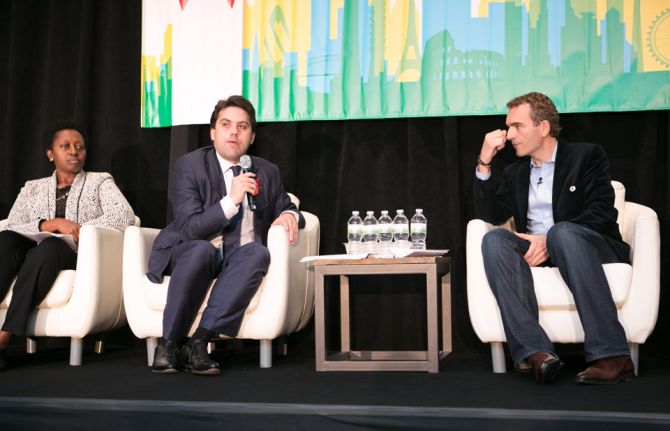
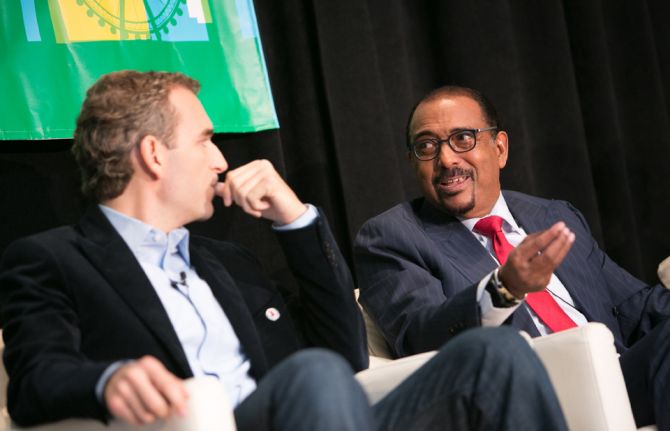

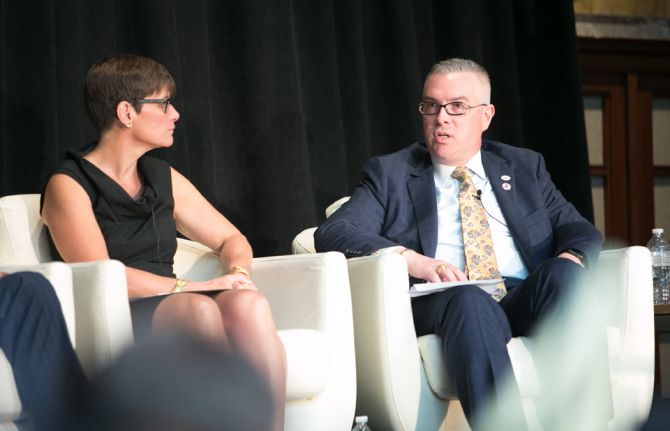

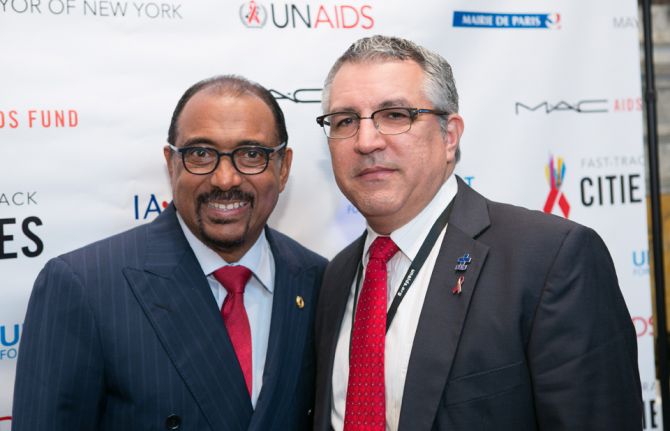

Press Statement
Mayors of New York and Paris convene a global meeting of mayors on ending AIDS in cities
06 June 2016 06 June 2016More than 30 cities playing a leading role in the AIDS response meet to discuss ongoing strategies and innovations in their cities that are improving health and development
NEW YORK/PARIS/GENEVA, 6 June 2016—The Mayor of New York, Bill de Blasio, and the Mayor of Paris, Anne Hidalgo, have convened a meeting in New York, United States of America, in collaboration with UNAIDS and the Fast-Track cities partners, UN-Habitat and the International Association of Providers of AIDS Care (IAPAC), on ending the AIDS epidemic in cities by 2030.
The meeting, made possible by the MAC AIDS Fund, was held at the New York Public Library on 6 June, ahead of the United Nations General Assembly High-Level Meeting on Ending AIDS, which is to take place at the United Nations Headquarters from 8 to 10 June.
“Today offers a unique opportunity to partner and explore how we can work together to educate, treat and prevent the spread of HIV, and here in New York City we echo those efforts through our work, including increased funding for HIV/AIDS prevention services and health care,” said the Mayor of New York, Bill de Blasio. “We are deeply proud of this work, but we must do more—I commend Mayor Hidalgo and the other mayors of great cities involved for their partnership in the global response to HIV.”
The cities event highlighted the essential leadership role that cities play in responding to HIV. Around 30 mayors from around the globe attended the event to discuss how they are getting on the Fast-Track to end AIDS in cities. They also shared how smart cities are implementing urban innovations to achieve the Sustainable Development Goals.
Later in the day, the mayors, UNAIDS and invited guests convened for The Problem Solvers: Cities on the Front Lines of HIV/AIDS, an Atlantic forum, presented by the MAC AIDS Fund and UNAIDS. The gathering provided an opportunity to take a closer look at the opportunities and challenges cities face in ending AIDS through a series of panels and conversations with mayors and urban leaders, health experts and advocates.
“Cities are at the forefront of the global strategy to end AIDS. Through the sale of M∙A∙C’s VIVA GLAM products, the M∙A∙C AIDS Fund has committed over $6 million to ending AIDS city by city – supporting locally relevant and targeted programs that reach the most vulnerable populations. We are proud to be the lead private funder in the Fast-Track Cities Initiative,” said Nancy Mahon, Senior Vice President, Global Corporate Citizenship and Sustainability for Estee Lauder. "The end of AIDS isn’t a talking point or catchy slogan for the M∙A∙C AIDS Fund. We are dedicated to making it happen with focused funding designed to make an immediate impact on the epidemic.”
Mayor Hidalgo was unable to attend the event in New York because of the emergency situation in Paris following heavy flooding, but sent a strong message of support.
“We all share the same certainty: we no longer have the right to stand by and watch as HIV worsens when solutions exist. And because the solutions exist, we no longer have any excuse for inaction,” said the Mayor of Paris, Anne Hidalgo. “Political will is at the forefront of responding to AIDS and I stand firmly to say: Paris is committed to ending the AIDS epidemic.”
Mayor Hidalgo was represented at the event by two deputy mayors, Patrick Klugman and Bernard Jomier.
Cities are at the front of the response to HIV and other health and equity challenges and are uniquely positioned to take transformative action. City leaders are already driving innovation and social transformation through ambitious responses to global challenges such as climate change and sustainable development.
"More than half of the world's population currently lives in cities,” said the UNAIDS Executive Director, Michel Sidibé. “City leadership on HIV is essential if the world is to achieve the Fast-Track Targets and end the AIDS epidemic by 2030.”
On World AIDS Day 2014, the Mayor of Paris welcomed 26 mayors from around the world, who signed a declaration to end the AIDS epidemic in their cities. In signing the 2014 Paris Declaration, the mayors committed to putting their cities on the Fast-Track to ending the AIDS epidemic through a set of commitments. Those commitments include achieving the UNAIDS 90–90–90 treatment target, which will result in 90% of people living with HIV knowing their HIV status, 90% of people who know their HIV-positive status on antiretroviral treatment and 90% of people on treatment with suppressed viral loads. Since the end of 2014, more than 200 cities around the world have signed the Paris Declaration and are addressing the significant disparities in access to basic services, social justice and economic opportunity towards ending the AIDS epidemic.
“Fast-Track cities are accelerating their local AIDS responses toward the goal of ending the AIDS epidemic as a public health threat by 2030,” said the IAPAC President/Chief Executive Officer, José M. Zuniga. “Our collaborative city-specific approach and real-time data generation afford us a precise understanding of gaps in city responses, which we are helping to address through targeted strategies to increase HIV testing, prevention, treatment and care.”
The event in New York provided an opportunity to share knowledge and draw on experiences from around the world. It brought together numerous partners, including the private sector, foundations and civil society. The opening session of the cities event was moderated by businessman and philanthropist Alexandre Mars of the Epic Foundation.
Media contacts
MAC AIDS Fund | Maripat Finigan | +1 860 508 3828 | maripat@praytellstrategy.com
UNAIDS Geneva | Sophie Barton-Knott | tel. +41 22 791 1697 | bartonknotts@unaids.org
Mairie de Paris | Mélanie Rigaud | tel. +33 6 40 93 09 99 | melanie.rigaud@paris.fr
New York City Office of the Mayor | + 1 212 788 2958 | pressoffice@cityhall.nyc.gov
IAPAC | Lindsay G. Deefholts | tel. + 1 416 301 7966 | ldeefholts@bell.net
La Mairie de Paris
The City of Paris has been committed to fighting AIDS since 2001 and the response has become a priority at both local and global levels. In collaboration with UNAIDS, UN-Habitat and IAPAC, it was natural for Paris to be involved in the launch the Fast-Track Cities Initiative (FTCI) on December 1, 2014. And Paris has taken a leading role. In February 2016, Paris published its own strategy called "Towards an AIDS free Paris", thanks to which The City will be a pioneer of the FTCI in regard to reaching the 90-90-90 targets by 2020.
UNAIDS
The Joint United Nations Programme on HIV/AIDS (UNAIDS) leads and inspires the world to achieve its shared vision of zero new HIV infections, zero discrimination and zero AIDS-related deaths. UNAIDS unites the efforts of 11 UN organizations—UNHCR, UNICEF, WFP, UNDP, UNFPA, UNODC, UN Women, ILO, UNESCO, WHO and the World Bank—and works closely with global and national partners towards ending the AIDS epidemic by 2030 as part of the Sustainable Development Goals. Learn more at unaids.org and connect with us on Facebook, Twitter, Instagram and YouTube.
IAPAC
The International Association of Providers of AIDS Care (IAPAC) represents more than 27,500 clinicians and allied health care professionals in over 150 countries. Its mission is to improve the quality of and increase access to HIV prevention, care, treatment, and support services for men, women, and children affected by and living with HIV and comorbid conditions (e.g., tuberculosis, viral hepatitis). For more information about IAPAC and its 30-year history of marshaling the health professions to end the AIDS epidemic, please visit www.iapac.org.
MAC AIDS Fund
The lead private funder of the Fast-Track Cities initiative, the MAC AIDS Fund is dedicated to serving people of all ages, all races and all sexes affected by HIV and AIDS, partnering with the bold, the visionary and the brave to confront the epidemic. The MAC AIDS FUND believes cities have long been at the forefront of responding to AIDS, committing more than $6 million to cities setting ambitious targets and accelerating the delivery of high-impact HIV prevention and treatment services. Raised exclusively through the sale of MAC VIVA GLAM lipstick and lipglass, the MAC AIDS Fund has raised more than $400 million since its inception in 1994 and will continue to support innovative efforts like the Fast-Track Cities initiative to help eradicate the epidemic.
Contact
MAC AIDS FundMaripat Finigan
tel. +1 860 508 3828
maripat@praytellstrategy.com
UNAIDS
Sophie Barton-Knott
tel. +41 79 514 6894
bartonknotts@unaids.org
Mairie de Paris
Mélanie Rigaud
tel. +33 6 40 93 09 99
melanie.rigaud@paris.fr
New York City Office of the Mayor
tel. + 1 212 788 2958
pressoffice@cityhall.nyc.gov
IAPAC
Lindsay G. Deefholts
tel. + 1 416 301 7966
ldeefholts@bell.net
Publications
Press centre
Download the printable version (PDF)

Press Statement
UNAIDS calls for inclusion and full participation of civil society organizations at the 2016 United Nations General Assembly High-Level Meeting on Ending AIDS
18 May 2016 18 May 2016GENEVA, 18 May 2016—From 8 to 10 June 2016, world leaders, government representatives, HIV programme implementers and civil society organizations from across the world will gather at the United Nations Headquarters in New York, United States of America, to chart the way forward to ending AIDS as a public health threat by 2030 as part of the Sustainable Development Goals.
It is crucial that the voices and perspectives of individuals and organizations be heard at this United Nations General Assembly High-Level Meeting on Ending AIDS, including the voices of people living with HIV and people most affected by the epidemic, including women and girls, sex workers, people who use drugs, gay men and other men who have sex with men and transgender people. Nongovernmental organizations working on the ground to ensure that no one is left behind must have the opportunity to contribute to this important forum.
Millennium Development Goal 6 of halting and reversing the AIDS epidemic and reaching the historic milestone of 15 million people on treatment by 2015 could not have been reached without the meaningful engagement and participation of people living with and affected by HIV.
The High-Level Meeting on Ending AIDS should be guided by the principles on which the successes of the AIDS response are built—inclusion, participation and dignity. As enshrined in the United Nations Charter, the doors of the United Nations should be open to all.
UNAIDS
The Joint United Nations Programme on HIV/AIDS (UNAIDS) leads and inspires the world to achieve its shared vision of zero new HIV infections, zero discrimination and zero AIDS-related deaths. UNAIDS unites the efforts of 11 UN organizations—UNHCR, UNICEF, WFP, UNDP, UNFPA, UNODC, UN Women, ILO, UNESCO, WHO and the World Bank—and works closely with global and national partners towards ending the AIDS epidemic by 2030 as part of the Sustainable Development Goals. Learn more at unaids.org and connect with us on Facebook, Twitter, Instagram and YouTube.
Press centre
Download the printable version (PDF)

Press Statement
UNAIDS calls for full and complete access to quality health care, including mental health care, for lesbian, gay, bisexual, transgender and intersex people
17 May 2016 17 May 2016GENEVA, 17 May 2016—UNAIDS stands with people and organizations around the world in commemorating the International Day against Homophobia, Transphobia and Biphobia (IDAHOT) on 17 May, the day 26 years ago when the World Health Organization declassified homosexuality as a mental disorder. The IDAHOT theme for 2016 is mental health and well-being.
Although there is still much progress to be made to achieve UNAIDS’ vision of zero discrimination, there have been encouraging steps in the right direction. In June 2015, Mozambique decriminalized homosexuality in its new penal code. In September 2015, some 12 United Nations agencies issued a powerful joint call to action on ending violence and discrimination against lesbian, gay, bisexual, transgender and intersex (LGBTI) people. In May 2016, the Government of the United States of America released guidance “to help provide educators the information they need to ensure that all students, including transgender students, can attend school in an environment free from discrimination based on sex.”
“It is unacceptable that lesbian, gay, bisexual, transgender and intersex (LGBTI) people face violence and discrimination just because of who they are and who they love,” said UNAIDS Executive Director Michel Sidibé. “They are our sons and daughters, our brothers and sisters, our friends and colleagues. LGBTI rights are human rights. We must challenge prejudice wherever we are.”
Many LGBTI people continue to face enormous daily challenges, sometimes living in fear, in isolation and out of reach of life-saving health services. Fear of abuse or discrimination by health-care workers prevents people from accessing HIV testing and treatment services. In addition, a large percentage of LGBTI people face isolation and discrimination in their immediate social environment, negatively affecting their mental health.
Reaching the Sustainable Development Goals, which include ending AIDS by 2030, requires the end of discrimination in all its forms.
UNAIDS calls for full and complete access to quality health care for LGBTI people, including access to mental health services, which are often less well supported in health systems. “Act with compassion. Embrace diversity. Leave no one behind,” added Mr Sidibé.
Ending discrimination will be one of the central themes discussed at the upcoming United Nations General Assembly High-Level Meeting on Ending AIDS, taking place at the United Nations in New York, United States of America, from 8 to 10 June 2016. For more information, go to www.hlm2016aids.unaids.org.
UNAIDS
The Joint United Nations Programme on HIV/AIDS (UNAIDS) leads and inspires the world to achieve its shared vision of zero new HIV infections, zero discrimination and zero AIDS-related deaths. UNAIDS unites the efforts of 11 UN organizations—UNHCR, UNICEF, WFP, UNDP, UNFPA, UNODC, UN Women, ILO, UNESCO, WHO and the World Bank—and works closely with global and national partners towards ending the AIDS epidemic by 2030 as part of the Sustainable Development Goals. Learn more at unaids.org and connect with us on Facebook, Twitter, Instagram and YouTube.
Press centre
Download the printable version (PDF)

Press Statement
UNAIDS calls for sustained investment and increased collaboration to develop an HIV vaccine
18 May 2016 18 May 2016GENEVA, 18 May 2016—On HIV Vaccine Awareness Day, UNAIDS calls for greater resources and increased collaboration among governments, the scientific community and the private sector to advance research towards finding an effective HIV vaccine.
“Developing an effective HIV vaccine would be a major scientific and medical breakthrough for humankind,” said UNAIDS Executive Director Michel Sidibé. “Alongside expanding access to existing antiretroviral medicines and combination HIV prevention tools, sustained investment and intensified collaboration to develop an HIV vaccine is needed to bring the world a step closer to ending the AIDS epidemic.”
In 2014, global investment in HIV vaccine research and development increased by 2.8%, to US$ 841 million, up from US$ 818 million in 2013. However, this rebound followed five years during which available resources either flatlined or declined, with a high of US$ 961 million in 2007. The United States of America remains the largest investor in HIV research and development.
Public–private and international partnerships have been formed to accelerate progress towards an effective HIV vaccine. UNAIDS is working together with partners, such as the International AIDS Vaccine Initiative, AVAC and other stakeholders, to advance research. UNAIDS is also an active participant in the annual vaccine funders’ meetings coordinated by the Global HIV Vaccine Enterprise to highlight the importance of continued research, sustained funding and coordinated responses towards HIV vaccine discovery.
Over the past 30 years, four concepts for an HIV vaccine have been tested in six efficacy trials. Of these, the RV144 vaccine trial in Thailand in 2009 was most promising, reducing HIV infection risk by 31%. It is hoped that ongoing research will lead to at least two further large-scale trials of vaccine candidates starting in the near future. At the same time, work continues to develop other potential vaccines, including a combined vaccine for HIV and hepatitis C. The effectiveness of neutralizing antibodies is also being studied.
An HIV vaccine will be necessary for the long-term control of HIV and is the best hope for sustaining the progress made towards ending the AIDS epidemic by 2030.
UNAIDS
The Joint United Nations Programme on HIV/AIDS (UNAIDS) leads and inspires the world to achieve its shared vision of zero new HIV infections, zero discrimination and zero AIDS-related deaths. UNAIDS unites the efforts of 11 UN organizations—UNHCR, UNICEF, WFP, UNDP, UNFPA, UNODC, UN Women, ILO, UNESCO, WHO and the World Bank—and works closely with global and national partners towards ending the AIDS epidemic by 2030 as part of the Sustainable Development Goals. Learn more at unaids.org and connect with us on Facebook, Twitter, Instagram and YouTube.
Press centre
Download the printable version (PDF)

Press Statement
UNAIDS urges countries to move towards a public health and human rights approach to people who use drugs
19 April 2016 19 April 2016NEW YORK/GENEVA, 19 April 2016—UNAIDS welcomes the United Nations General Assembly’s call for Member States to consider effective public health measures to improve outcomes for people who use drugs and urges countries to implement programmes that reduce the impact of the harms associated with drug use.
The outcome document adopted by Member States at the United Nations General Assembly Special Session (UNGASS) on the World Drug Problem, being held in New York, United States of America, calls on countries to consider measures such as appropriate medication-assisted therapy, injecting equipment programmes and antiretroviral therapy to prevent the transmission of HIV, viral hepatitis and other bloodborne viruses.
The outcome document also underlines the need for the full respect of the human rights and fundamental freedoms of people who use drugs, including a fair trial and proportionate sentencing for people arrested for or convicted of drugs offences. It encourages countries to consider alternatives to punishment.
“The world has taken a step towards a more rational and compassionate approach to people who inject drugs,” said the UNAIDS Executive Director, Michel Sidibé. “Countries can only reverse their HIV epidemics by implementing policies and programmes that are proved to work and put people first, including people who use drugs.”
In the lead-up to the UNGASS, UNAIDS has stressed that there is insufficient coverage of harm reduction programmes and that policies that criminalize and marginalize people who use drugs are failing to reduce HIV infections, especially among people who inject drugs. There was no reduction in the number of new HIV infections among people who inject drugs between 2010 and 2014. The world has missed the United Nations General Assembly’s target set in 2011 to reduce HIV transmission among people who inject drugs by 50% by 2015.
The newly published UNAIDS report, Do no harm: health, human rights and people who use drugs, shows that countries that implement health- and rights-based approaches have reduced new HIV infections among people who inject drugs. Countries that stop putting people in prison for drugs offences but give them access to expanded treatment programmes report the best results. Countries should commit to treating people with support and care, rather than punishment. UNAIDS recommends decriminalization and stopping incarceration of people for the consumption and possession of drugs for personal use.
The UNGASS outcome document recognizes the need for closer cooperation between health, education, justice and law enforcement authorities and emphasizes the role of civil society, the scientific community and academia in addressing the world drug problem. It reiterates the General Assembly’s commitment to end the epidemics of AIDS and tuberculosis as part of the Sustainable Development Goals and to reduce the impact of viral hepatitis and other infectious diseases, including among people who use drugs.
The UNAIDS Fast-Track approach has a set of targets for 2020 that include reducing new HIV infections to fewer than 500 000. It also calls on countries to ensure that 90% of the more than 12 million people who inject drugs worldwide have access to combination HIV prevention services, including needle–syringe programmes, opioid substitution therapy, condoms and access to counselling, care, testing and treatment services for tuberculosis and bloodborne viruses such as HIV and hepatitis B and C. Achieving these targets will be a significant step towards ending the AIDS epidemic as a public health threat by 2030.
UNAIDS
The Joint United Nations Programme on HIV/AIDS (UNAIDS) leads and inspires the world to achieve its shared vision of zero new HIV infections, zero discrimination and zero AIDS-related deaths. UNAIDS unites the efforts of 11 UN organizations—UNHCR, UNICEF, WFP, UNDP, UNFPA, UNODC, UN Women, ILO, UNESCO, WHO and the World Bank—and works closely with global and national partners towards ending the AIDS epidemic by 2030 as part of the Sustainable Development Goals. Learn more at unaids.org and connect with us on Facebook, Twitter, Instagram and YouTube.
Press centre
Download the printable version (PDF)

Press Statement
UNAIDS calls for stronger partnerships to end the epidemics of tuberculosis and HIV
23 March 2016 23 March 2016GENEVA, 24 March 2016—On World Tuberculosis (TB) Day, UNAIDS is calling for stronger partnerships and a united approach to end the twin epidemics of TB and HIV and save millions of lives. It has never been more urgent for governments, the medical and scientific communities, the private sector and people affected by the diseases to come together to ensure access to existing treatment regimens and to push for new diagnostic tools and treatments to reach all people in need.
“We achieve the most when we work together and use all our strengths to reach ambitious goals,” said UNAIDS Executive Director, Michel Sidibé. “Harnessing the potential of everyone involved in the response to HIV and TB is needed now more than ever to end these epidemics and create a healthier world as part of the Sustainable Development Goals.”
Globally, 9.6 million people fell ill with TB in 2014 and 1.5 million people died of the disease. TB also remains the leading cause of death among people living with HIV, accounting for one in three AIDS-related deaths every year – around 390 000 of 1.2 million AIDS-related deaths in 2014. In addition, around 480 000 people in 2014 developed multidrug-resistant TB. As with HIV, poorer communities and populations affected by stigma and discrimination are most vulnerable to infection.
The international community is committed to ending the epidemics of TB and HIV within the framework of the Sustainable Development Goals. This will be possible only by strengthening and accelerating current responses and by maximizing the contribution of all those involved through a united approach at the international, regional, national and community levels. For example, the development of new diagnostic tools, treatments and potential vaccines against HIV and TB must be speeded up, especially in response to the emergence of multi-drug resistant tuberculosis. Most importantly, these new regimens and tools must be within reach of everyone affected by TB and HIV.
Adopted in 2014, the World Health Organization’s END TB Strategy recognizes that ending the TB epidemic hinges on better policy-making at an international, regional and national level as well as stronger action to increase social protection, reduce poverty and tackle other determinants that increase people’s vulnerability to infection. The strengthening of health-care capacities will also be an important factor in reaching the goals of reducing TB deaths by 95% and new cases of TB by 90% by 2035. The same factors apply to ending the HIV epidemic.
UNAIDS remains committed to working closely together with countries, donors, communities and partners including the World Health Organization, the Stop TB Partnership and the Global Fund to Fight AIDS, Tuberculosis and Malaria to maximize the full power of communities everywhere to end the epidemics of TB and HIV.
UNAIDS
The Joint United Nations Programme on HIV/AIDS (UNAIDS) leads and inspires the world to achieve its shared vision of zero new HIV infections, zero discrimination and zero AIDS-related deaths. UNAIDS unites the efforts of 11 UN organizations—UNHCR, UNICEF, WFP, UNDP, UNFPA, UNODC, UN Women, ILO, UNESCO, WHO and the World Bank—and works closely with global and national partners towards ending the AIDS epidemic by 2030 as part of the Sustainable Development Goals. Learn more at unaids.org and connect with us on Facebook, Twitter, Instagram and YouTube.
Press centre
Download the printable version (PDF)

Press Statement
UNAIDS welcomes South Africa’s groundbreaking National Sex Worker HIV Plan
11 March 2016 11 March 2016Deputy President Cyril Ramaphosa launches a comprehensive plan to prevent and treat HIV among sex workers
GENEVA, 11 March 2016—UNAIDS welcomes the roll-out of South Africa’s National Sex Worker HIV Plan, 2016–2019. Launched by the Deputy President of South Africa, Cyril Ramaphosa, in his role as the Chairperson of the South African National AIDS Council (SANAC), this unique plan will ensure equitable access to health and legal services for sex workers in South Africa.
Sex workers experience a disproportionate burden of HIV, sexually transmitted infections, tuberculosis, violence, and stigma and discrimination. This progressive plan outlines a comprehensive and nationally coordinated response that is tailored to their specific needs and includes a core package of services for sex workers, their partners, their clients and their families.
As well as delivering access to health services to prevent and treat HIV, sexually transmitted infections and tuberculosis, the plan also aims to provide sex workers with access to justice and legal protection services. These services will be made available through a combination of peer educators, community-driven outreach and referrals, and specialized clinics, as well as through primary health-care clinics, with training for all health workers.
The plan includes making HIV testing available and accessible for sex workers. Sex workers who test HIV-positive will be offered antiretroviral therapy. Sex workers who are HIV-negative will be offered antiretroviral medicines to prevent HIV infection—pre-exposure prophylaxis (PrEP)—in combination with other HIV prevention services.
“South Africa continues to lead and innovate,” said UNAIDS Executive Director Michel Sidibé. “By listening to sex workers and collaborating with the community, South Africa’s tailor-made national HIV plan offers real hope for sex workers, who are often left behind in the AIDS response.”
The results of the Integrated Biological and Behavioural Surveillance survey, launched alongside the report today, demonstrate that HIV prevalence among female sex workers can be as high as 72% in South Africa, but with marked variation in prevalence between different urban settings. Furthermore, the study shows that uptake of antiretroviral therapy by female sex workers already know to be living with HIV is lower than the national average. In 2013, a rapid size estimation study commissioned by SANAC estimated that there were approximately 153 000 sex workers (female, male and transgender) in South Africa; most live and work in the main cities. Studies indicate that HIV prevalence among female sex workers is three to four times higher than among adult women in the general population.
Comprehensive HIV combination prevention, treatment and care services need to reach people who are at higher risk. Ending the AIDS epidemic relies on leaving nobody behind.
UNAIDS
The Joint United Nations Programme on HIV/AIDS (UNAIDS) leads and inspires the world to achieve its shared vision of zero new HIV infections, zero discrimination and zero AIDS-related deaths. UNAIDS unites the efforts of 11 UN organizations—UNHCR, UNICEF, WFP, UNDP, UNFPA, UNODC, UN Women, ILO, UNESCO, WHO and the World Bank—and works closely with global and national partners towards ending the AIDS epidemic by 2030 as part of the Sustainable Development Goals. Learn more at unaids.org and connect with us on Facebook, Twitter, Instagram and YouTube.
Press centre
Download the printable version (PDF)
Region/country

Press Statement
Harnessing the collective strengths of the UN system to reach every woman, child, and adolescent
18 March 2016 18 March 2016As part of the global effort to achieve the Millennium Development Goals (MDGs), countries around the world reported major gains in the health and wellbeing of women and children between 1990 and 2015. The global rate of maternal mortality fell by 47 per cent and child mortality declined by 49 per cent. However, any celebration of progress is tempered by the reality that millions of women, children, newborns, and adolescents continue to die every year; mostly from preventable causes. As the world transitions from the MDGs to the Sustainable Development Goals (SDGs), we must uphold our commitment to keep reproductive, maternal, newborn, child, and adolescent health (RMNCAH) at the heart of the global agenda. Fulfilling this promise is both a practical imperative and a moral obligation.
The UN Secretary-General's Global Strategy for Women's, Children's, and Adolescents' Health sets out a plan to give every woman, child, and adolescent the opportunity to not only survive, but to thrive and transform his or her community. Implementing the Global Strategy and achieving the SDG targets requires an unprecedented level of alignment and coordination amongst each and every one of us working in the field of RMNCAH.
On behalf of the six organizations responsible for promoting and implementing the global health agenda across the UN system, UNAIDS, UNFPA, UNICEF, UN Women, WHO, and the World Bank Group, we, the undersigned, stand united in our commitment to operationalize the Global Strategy.
Building on our tradition of working together to support countries in achieving the MDGs, we, as members of the H6 (previously known as the H4+), will provide coordinated technical support to country-led efforts to implement the Global Strategy and achieve the ambitious targets of the health-related SDGs. At the same time, we will continue to advocate for evidence-based RMNCAH programmes and policies at the global, regional, and national levels.
As the current H6 chair (2016-2018), UNAIDS will lead the partnership in fulfilling its mandate to leverage the strengths and capacities of each of the six member organizations in order to support high-burden countries in their efforts to improve the survival, health, and well-being of every woman, newborn, child, and adolescent.
As representatives of the H6, we renew our commitment to implement this mandate in support of the Global Strategy. We call on RMNCAH activists and advocates worldwide to join us in fulfilling this shared pledge to women, children, and adolescents everywhere.
Michel Sidibé, Executive Director, UNAIDS
Babatunde Osotimehin, Executive Director, UNFPA
Anthony Lake, Executive Director, UNICEF
Phumzile Mlambo-Ngcuka, Executive Director, UN Women
Margaret Chan, Director General, WHO
Tim Evans, Senior Director, Health, Nutrition and Population Global Practice, The World Bank Group
UNAIDS
The Joint United Nations Programme on HIV/AIDS (UNAIDS) leads and inspires the world to achieve its shared vision of zero new HIV infections, zero discrimination and zero AIDS-related deaths. UNAIDS unites the efforts of 11 UN organizations—UNHCR, UNICEF, WFP, UNDP, UNFPA, UNODC, UN Women, ILO, UNESCO, WHO and the World Bank—and works closely with global and national partners towards ending the AIDS epidemic by 2030 as part of the Sustainable Development Goals. Learn more at unaids.org and connect with us on Facebook, Twitter, Instagram and YouTube.
Press centre
Download the printable version (PDF)

